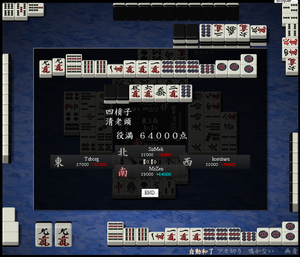Multiple yakuman: Difference between revisions
| Line 19: | Line 19: | ||
===Full scoring=== | ===Full scoring=== | ||
In many rulesets, not only are yakuman cumulative, but certain particularly rare and difficult hands are worth double the score value of a normal yakuman. For the most part, | In many rulesets, not only are yakuman cumulative, but certain particularly rare and difficult hands are worth double the score value of a normal yakuman. For the most part, four yakuman patterns may produce specific instances, that are worth double yakuman by themselves. | ||
* [[Daisuushi]] is more difficult to complete than the lesser hand [[shousuushi]] | * [[Daisuushi]] is more difficult to complete than the lesser hand [[shousuushi]]. While both are classed as yakuman, daisuushi can be worth double yakuman. | ||
* [[Kokushi musou]] | * [[Kokushi musou]] can be double yakuman when completed on a 13-sided wait. | ||
* [[Chuuren poutou]] | * [[Chuuren poutou]] can be double yakuman when completed on a 9-sided wait. | ||
* [[Suuankou]] | * [[Suuankou]] can be double yakuman when completed on a [[tanki]] wait. This is also the only way that the hand can win by [[ron]]. | ||
Once again, the double yakuman on these patterns are only applied, if the double yakuman rule is applied to all or any of them. | |||
==Examples== | ==Examples== | ||
Revision as of 05:24, 12 April 2015

Multiple yakuman involve hands with more than one yakuman, as the name implies. While regular yaku may be stacked in one hand to raise value, the same can be done with different yakuman, where applicable.
In terms of scoring, the number of yakuman in the hand serves as a multiplier to the base yakuman point value. As a result, extremely high scoring hands are made possible.
If, in addition to one or more regular yakuman, the hand would also be a kazoe yakuman, no extra yakuman is added for this. For regular yakuman, han from normal yaku and dora are not counted.
Scoring
Application of the multiple yakuman may vary, as some rules do not allow multiple yakuman in terms of scoring. This is largely due to the extremely high value applied by multiple yakuman. In this case, even if the hand is composed of multiple yakuman, the score payout may be capped.
Single yakuman cap
Many professional organizations in Japan limit all payouts to a single yakuman, being 32,000 point for nondealer and 48,000 points for the dealer. This means that there are no double yakuman, and yakuman are not cumulative.
Cumulative single yakuman
Some groups, most notably Tenhou.net, do not award double yakuman for any specific hand, but will award double yakuman if two different yakuman are completed in the same hand—most commonly tsuuiisou alongside either shousuushi or daisangen.
Full scoring
In many rulesets, not only are yakuman cumulative, but certain particularly rare and difficult hands are worth double the score value of a normal yakuman. For the most part, four yakuman patterns may produce specific instances, that are worth double yakuman by themselves.
- Daisuushi is more difficult to complete than the lesser hand shousuushi. While both are classed as yakuman, daisuushi can be worth double yakuman.
- Kokushi musou can be double yakuman when completed on a 13-sided wait.
- Chuuren poutou can be double yakuman when completed on a 9-sided wait.
- Suuankou can be double yakuman when completed on a tanki wait. This is also the only way that the hand can win by ron.
Once again, the double yakuman on these patterns are only applied, if the double yakuman rule is applied to all or any of them.
Examples
* Single yakuman cap: 1 yakuman. * Cumulative single yakuman: 1 yakuman. * Full scoring: 2 yakuman.
* Single yakuman cap: 1 yakuman. * Cumulative single yakuman: 2 yakuman. * Full scoring: 2 yakuman.
* Single yakuman cap: 1 yakuman. * Cumulative single yakuman: 2 yakuman. * Full scoring: 2 yakuman.
* Single yakuman cap: 1 yakuman. * Cumulative single yakuman: 3 yakuman. * Full scoring: 4 yakuman.
Game examples
- 【麻雀】福光聖雄の小四喜・字一色!! (YouTube)
- Shousuushi + Tsuuiisou
| |||||||||||||||||||||||||||||||
